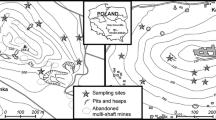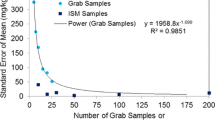Abstract
Environmental sampling of soils is carried out to monitor or characterise the concentration of substances in this environmental compartment. In potentially contaminated sites, sampling is used to characterise the quality of soils, general or specificity, depending on the historical activity developed in an area. The need to assess potentially contaminated areas by the most diverse substances (compounds or chemical elements), some of the less common, such as explosives, or the contamination (with some diffuse character) resulting from the deposition of substances by air, has led to the requirement to establish different strategies to approach the evaluation of these areas. Instead of a discrete sampling (D.S.) distributed at random, conditioned, or in mesh, there may be the convenience or the need for an incremental sampling (I.S.). This sampling strategy is appropriate for certain specific conditions, sampling objectives, and particular contaminants to obtain a single sample for analysis (at least three field replicates), representing the mean concentrations of elements and compounds of the decision unit adopted. This work intends to present the major features of the I.S. strategy and its advantages and disadvantages when comparing it with the common practice of the D.S. strategy.
Access this chapter
Tax calculation will be finalised at checkout
Purchases are for personal use only
Similar content being viewed by others
References
Brewer R, Peard J, Heskett M (2017) A critical review of discrete soil sample data reliability: part 1—field study results. Soil Sedim Cont Int J 26(1):1–22
Esbensen KH (2004) 50 Years of Pierre Gy’s theory of sampling—WCSB1: a tribute. Chem Intellig Laborat Systs 74(1):3–6
Hewitt AD, Jenkins TF, Walsh ME, Walsh MR, Bigl SR, Ramsey CA (2007) Protocols for collection of surface soil samples at military training and testing ranges for the characterisation of energetic munitions constituents. Technical Report ERDC/CRREL TR-07–10. U.S. Army Corps of Engineering
ITRC (2012) Incremental sampling methodology. Interstate Technology Regulatory Council, Washington
ITRC (2020) Incremental sampling methodology—2. Interstate Technology Regulatory Council, Washington
NSW-EPA (1995) Contaminated sites—sampling design guidelines. New South Wales Environment Protection Authority, Contaminated Sites Section, Hazardous Substances Branch, Sydney
USACE (2009) Implementation of incremental sampling (I.S.) of soil for the military munitions response program. Interim Guidance 09-02. Environmental and Munitions Center of Expertise. U.S. Army Corps of Engineers
USACE (2013) Demonstration of incremental sampling methodology for soil containing metallic residues. Project ER-0918. ERDC TR-13-9. U.S. Army Corps of Engineers and Engineering Research and Development Center
USEPA (2002) Guidance on choosing a sampling design for environmental data collection—for use in develo** a quality assurance project plan. EPA QA/G-5S. EPA/240/R-02/005. U.S. Environmental Protection Agency
USEPA (2006) Method 8330B—Nitroaromatics, nitramines, and nitrate esters by high performance liquid chromatography (HPLC). Test Methods for Evaluating Solid Waste: Physical/Chemical Methods/ SW-846 Compendium
USEPA (2010) Sampling design—modulo at a glance. Environmental Protection Agency, Sampling design and optimisation. U.S
USEPA (2019) Incremental sampling methodology (ISM) at polychlorinated biphenyl (PCB) Cleanup Sites. Environmental Protection Agency, U.S
Author information
Authors and Affiliations
Corresponding author
Editor information
Editors and Affiliations
Rights and permissions
Copyright information
© 2023 The Author(s), under exclusive license to Springer Nature Switzerland AG
About this paper
Cite this paper
Jorge, C. (2023). The Multi-incremental Sampling Methodology in the Study of Potential Contaminated Sites. In: Chaminé, H.I., Fernandes, J.A. (eds) Advances in Geoengineering, Geotechnologies, and Geoenvironment for Earth Systems and Sustainable Georesources Management. Advances in Science, Technology & Innovation. Springer, Cham. https://doi.org/10.1007/978-3-031-25986-9_37
Download citation
DOI: https://doi.org/10.1007/978-3-031-25986-9_37
Published:
Publisher Name: Springer, Cham
Print ISBN: 978-3-031-25985-2
Online ISBN: 978-3-031-25986-9
eBook Packages: Earth and Environmental ScienceEarth and Environmental Science (R0)




